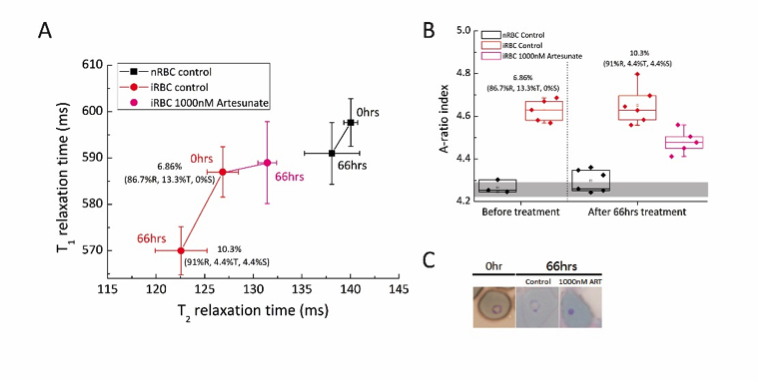Novel rapid phenotypic assays for detection of Artemisinin-resistant Plasmodium Falciparum with magnetic resonance relaxometry System
in collaboration with SBS, Nanyang Technological University
The recent emergence of artemisinin-resistance parasites is posing real threat to the world malaria control, treatment and elimination efforts. In low transmission area (e.g., Cambodia), parasites clearance studies requires screening thousands of febrile patient and thus logistically demanding. Witkowski et al. have recently proposed a novel in-vitro ring-stage survival assay (RSA)1 to detect resistance parasites. RSA, however, suffers from low sensitivity, accuracy, and long experiment time (>72 hours) due to the inherent limitation of giemsa-stained microscopy technique. In this work, we aim to develop a rapid (<1 hr) in-vitro assay (directly from patient) that can identify sensitive/resistant parasite accurately, understand the molecular mechanism behind artemisinin resistance, and identify phenotypic alternations that lead to resistance, using the recently developed rapid phenotyping Magnetic Resonance Relaxometry (MRR) system.
Methodology: Both the artemisinin sensitive and resistant P.falciparum 3D7 strain were used to assess the drug-responses by means of MRR and compared with conventional histology technique. The proton spin-lattice relaxation time (T1) and spin-spin relaxation time (T2) of the red blood cells (RBCs) were used to characterize the changes of bulk magnetic susceptibility. Optical, magnetic and electrical characterization were performed on hemozoin and artemisinin to study the kinetic and dosage dependant profile.
Preliminary results: Drug treated RBCs have substantially much shorter the T1 and T2 relaxation times compared to non-treated RBCs, with a systematic reduction in the T1/T2 ratio (denoted as A-ratio) (Fig. 1A and Fig. 1B). This correspond to the death of parasites, as independently verified by Giemsa-stained slide microscopy (Fig. 1C). Culture-adapted parasite strain with long clearance half-life (resistant) to the assay will be used in future. The drug exposure time will also be shortened to less than one hour targeted time.
Impact: Artemisinin is one of the last line of defense for malaria treatment, and yet patients with slow parasites clearance upon receiving ART is on the rise. We aim to provide rapid phenotyping assay suitable for field use to define and validate molecular markers for tracking the art-resistance parasites.
Last updated: 18 MAY 2015
Author: Aoli Xiong

